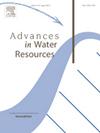Phase diagram of invasion patterns in «capillary number, wetting angle, disorder» coordinates: A lattice Boltzmann study
IF 4
2区 环境科学与生态学
Q1 WATER RESOURCES
引用次数: 0
Abstract
Pore space heterogeneity, numerically described by the disorder parameter, is a factor that strongly influences the displacement mechanics in porous media. This paper presents a systematic study of the simultaneous effects of capillary number, wetting angle, and pore space disorder on the invasion patterns of immiscible displacement: viscous and capillary fingering, compact displacement, and various crossover regimes. The results are based on lattice Boltzmann simulations performed on synthetic micromodels and natural X-ray computed tomography models of natural sandstones. This paper addresses two objectives. The first is to present for the first time a three-dimensional phase diagram in «capillary number, wetting angle, disorder» coordinates, which accurately indicates the regions of invasion patterns. The identification is based on a number of displacement characteristics, such as sweep efficiency map, fractal dimension, and the dynamics of the leading front movement. Based on the phase diagram, the critical wetting angles, which define the boundary of the viscous fingering, capillary fingering, and compact displacement regimes, shift towards imbibition with increasing disorder. A decrease in capillary number shifts the critical wetting angles for the viscous fingering and compact displacement modes towards drainage, and for the capillary fingering mode towards imbibition. The second goal is to identify the maximum effect of pore space disorder on sweep efficiency as a function of capillary number and wetting angle. It has been found that at high capillary numbers the disorder effect is independent of the wetting angle. A decrease in capillary number enhances the maximum disorder effect on sweep efficiency and it becomes strongly dependent on the wetting angle. With increased capillary forces the transition from deep imbibition and drainage regimes to the mode with neutral wettability greatly enhances the effect of disorder. The extremum point of wetting angle, at which the effect of disorder is maximum, shifts towards drainage with decreasing capillary number.
在“毛细数,湿润角,无序”坐标系中侵入模式的相图:晶格玻尔兹曼研究
孔隙空间非均质性是影响多孔介质位移力学的一个重要因素,用失序参数进行数值描述。本文系统地研究了毛细管数量、润湿角和孔隙空间无序对非混相驱替侵入模式的同时影响:粘性和毛细管指进、致密驱替和各种交叉机制。结果是基于在合成微模型和天然砂岩的自然x射线计算机断层扫描模型上进行的晶格玻尔兹曼模拟。本文涉及两个目标。第一个是首次以“毛细数、润湿角、无序度”坐标给出三维相图,准确地指示了侵入模式的区域。该识别是基于一些位移特征,如扫描效率图、分形维数和前缘运动动力学。从相图上看,临界润湿角(定义粘指理、毛细指理和致密驱替体系的边界)随着无序度的增加而向吸胀方向移动。毛细管数的减少使黏性指控和致密驱替模式的临界润湿角向排水方向移动,使毛细管指控模式的临界润湿角向吸胀方向移动。第二个目标是确定孔隙空间紊乱对扫描效率的最大影响,作为毛细管数和润湿角的函数。研究发现,在高毛细数时,失序效应与润湿角无关。毛细数的减少增强了扫频效率的最大无序效应,并与润湿角有强烈的关系。随着毛细力的增加,从深度吸吸和排水模式到中性润湿性模式的转变大大增强了无序的效果。随着毛细数的减少,润湿角的极值点向排水方向移动,在此点上无序效应最大。
本文章由计算机程序翻译,如有差异,请以英文原文为准。
求助全文
约1分钟内获得全文
求助全文
来源期刊

Advances in Water Resources
环境科学-水资源
CiteScore
9.40
自引率
6.40%
发文量
171
审稿时长
36 days
期刊介绍:
Advances in Water Resources provides a forum for the presentation of fundamental scientific advances in the understanding of water resources systems. The scope of Advances in Water Resources includes any combination of theoretical, computational, and experimental approaches used to advance fundamental understanding of surface or subsurface water resources systems or the interaction of these systems with the atmosphere, geosphere, biosphere, and human societies. Manuscripts involving case studies that do not attempt to reach broader conclusions, research on engineering design, applied hydraulics, or water quality and treatment, as well as applications of existing knowledge that do not advance fundamental understanding of hydrological processes, are not appropriate for Advances in Water Resources.
Examples of appropriate topical areas that will be considered include the following:
• Surface and subsurface hydrology
• Hydrometeorology
• Environmental fluid dynamics
• Ecohydrology and ecohydrodynamics
• Multiphase transport phenomena in porous media
• Fluid flow and species transport and reaction processes
 求助内容:
求助内容: 应助结果提醒方式:
应助结果提醒方式:


